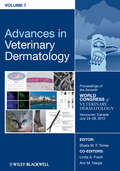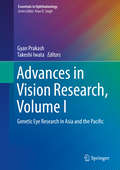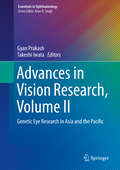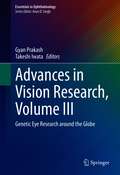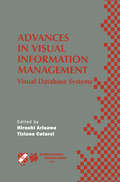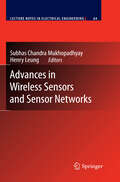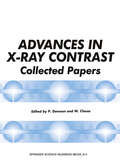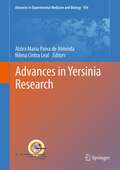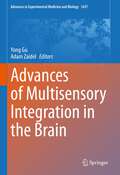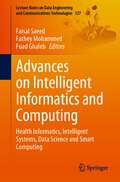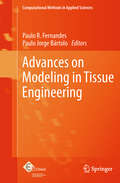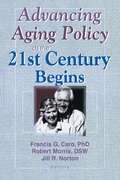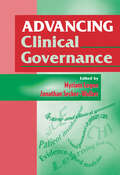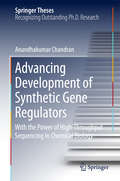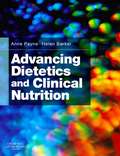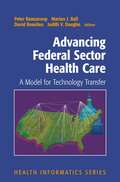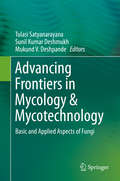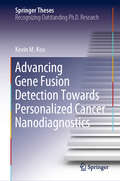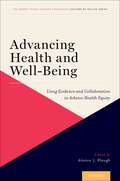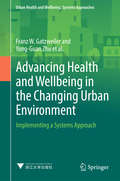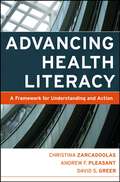- Table View
- List View
Advances in Veterinary Dermatology, Volume 7: Proceedings of the Seventh World Congress of Veterinary Dermatology, Vancouver, Canada, July 24 - 28, 2012
by Sheila M. F. TorresRepresenting the state of the art of veterinary dermatology around the globe, Advances in Veterinary Dermatology, Volume 7, presents selected scientific papers from the Seventh World Congress of Veterinary Dermatology. The Congress, held in Vancouver, Canada in July 2012, was organized with the support of the World Association for Veterinary Dermatology (WAVD) and its affiliated societies. A record number of delegates attended from over 50 countries to take advantage of the exceptional scientific program. Cutting edge information was presented as review papers and original studies in the areas of: Allergy Immunology Skin Biology Therapy Infectious Diseases Oncology These peer-reviewed and edited papers were published in the journal Veterinary Dermatology in volume 24, issue 1, and are included in this hardbound book volume of the conference proceedings. Also included are 13 Workshop Reports which summarise sessions where experts presented topics in various areas providing a wonderful opportunity for colleagues to ask questions and exchange ideas in an informal atmosphere. A vital resource for all practising veterinarians and researchers interested in the field of veterinary dermatology.
Advances in Veterinary Dermatology, Volume 7: Proceedings of the Seventh World Congress of Veterinary Dermatology, Vancouver, Canada, July 24 - 28, 2012
by Sheila M. F. Torres Linda A. Frank Ann M. HargisRepresenting the state of the art of veterinary dermatology around the globe, Advances in Veterinary Dermatology, Volume 7, presents selected scientific papers from the Seventh World Congress of Veterinary Dermatology. The Congress, held in Vancouver, Canada in July 2012, was organized with the support of the World Association for Veterinary Dermatology (WAVD) and its affiliated societies. A record number of delegates attended from over 50 countries to take advantage of the exceptional scientific program. Cutting edge information was presented as review papers and original studies in the areas of: Allergy Immunology Skin Biology Therapy Infectious Diseases Oncology These peer-reviewed and edited papers were published in the journal Veterinary Dermatology in volume 24, issue 1, and are included in this hardbound book volume of the conference proceedings. Also included are 13 Workshop Reports which summarise sessions where experts presented topics in various areas providing a wonderful opportunity for colleagues to ask questions and exchange ideas in an informal atmosphere. A vital resource for all practising veterinarians and researchers interested in the field of veterinary dermatology.
Advances in Vision Research, Volume I: Genetic Eye Research in Asia and the Pacific (Essentials in Ophthalmology)
by Gyan Prakash Takeshi IwataThis book presents the state of the art in genetic eye research in Asia and the Pacific. Though there has been an explosion of information on genetic eye research in western countries, more than sixty percent of the human genes involved in eye diseases in the Asian and Pacific population remain unknown. However, new efforts and a new awareness have sparked important discussions on the subject, and new plans are being implemented to discover the genes responsible for many eye diseases in the population. The book reviews the latest findings; its content ranges from genetic aspects of human migration to DNA sequence analysis, genome-wide association analysis, and disease phenotypes. The efforts of the Asian Eye Genetic Consortium (AEGC) are also discussed. The book’s editors have been instrumental in developing strategies for discovering the new Asian genes involved in many eye diseases. All chapters were written by leading researchers working on Asian eye genetics from the fields of Human Genetics, Ophthalmology, Molecular Biology, Biochemistry, Sensory Sciences, and Clinical Research. Advances in Vision Research, Volume I will prove to be a major resource for all researchers, clinicians, clinical researchers, and allied eye health professionals with an interest in eye diseases among the Asian population.
Advances in Vision Research, Volume II: Genetic Eye Research In Asia And The Pacific (Essentials In Ophthalmology Ser.)
by Gyan Prakash Takeshi IwataThis second volume continues with a focus on the state of the art in genetic eye research in Asia and the Pacific. Though there has been an explosion of information on genetic eye research in western countries, more than sixty percent of the human genes involved in eye diseases in the Asian and Pacific population remain unknown. However, new efforts and a new awareness have sparked important discussions on the subject, and new plans are being implemented to discover the genes responsible for many eye diseases in the population. The book reviews the latest findings; its content ranges from genetic aspects of human migration to DNA sequence analysis, genome-wide association analysis, and disease phenotypes. The efforts of the Asian Eye Genetic Consortium (AEGC) are also discussed. The book’s editors have been instrumental in developing strategies for discovering the new Asian genes involved in many eye diseases. All chapters were written by leading researchers working on Asian eye genetics from the fields of Human Genetics, Ophthalmology, Molecular Biology, Biochemistry, Sensory Sciences, and Clinical Research. Advances in Vision Research, Volume II will prove to be a major resource for all researchers, clinicians, clinical researchers, and allied eye health professionals with an interest in eye diseases among the Asian population.
Advances in Vision Research, Volume III: Genetic Eye Research around the Globe (Essentials in Ophthalmology)
by Gyan Prakash Takeshi IwataThis third volume, with three supporting editors, broadens its focus on genetic eye research from the Asian to the global scale. New efforts and a new awareness have sparked important discussions on genetic eye research, and new plans are being implemented to identify the genes responsible for numerous eye diseases. The book introduces the latest findings on genetics in eye diseases, gene therapy, and genome-wide association analysis, and the efforts of the Global Eye Genetic Consortium (GEGC). The book’s editors have been instrumental in developing strategies for discovering the new genes involved in many eye diseases. All chapters were written by leading researchers working on eye genetics from the fields of Human Genetics, Ophthalmology, Molecular Biology, Biochemistry, Sensory Sciences, and Clinical Research. Advances in Vision Research, Volume III is a major resource for all researchers, clinicians, clinical researchers, and allied eye health professionals with an interest in eye diseases around the globe.
Advances in Visual Information Management: Visual Database Systems. IFIP TC2 WG2.6 Fifth Working Conference on Visual Database Systems May 10–12, 2000, Fukuoka, Japan (IFIP Advances in Information and Communication Technology #40)
by Hiroshi Arisawa Tiziana CatarciVideo segmentation is the most fundamental process for appropriate index ing and retrieval of video intervals. In general, video streams are composed 1 of shots delimited by physical shot boundaries. Substantial work has been done on how to detect such shot boundaries automatically (Arman et aI. , 1993) (Zhang et aI. , 1993) (Zhang et aI. , 1995) (Kobla et aI. , 1997). Through the inte gration of technologies such as image processing, speech/character recognition and natural language understanding, keywords can be extracted and associated with these shots for indexing (Wactlar et aI. , 1996). A single shot, however, rarely carries enough amount of information to be meaningful by itself. Usu ally, it is a semantically meaningful interval that most users are interested in re trieving. Generally, such meaningful intervals span several consecutive shots. There hardly exists any efficient and reliable technique, either automatic or manual, to identify all semantically meaningful intervals within a video stream. Works by (Smith and Davenport, 1992) (Oomoto and Tanaka, 1993) (Weiss et aI. , 1995) (Hjelsvold et aI. , 1996) suggest manually defining all such inter vals in the database in advance. However, even an hour long video may have an indefinite number of meaningful intervals. Moreover, video data is multi interpretative. Therefore, given a query, what is a meaningful interval to an annotator may not be meaningful to the user who issues the query. In practice, manual indexing of meaningful intervals is labour intensive and inadequate.
Advances in Wireless Sensors and Sensor Networks (Lecture Notes in Electrical Engineering #64)
by Subhas Chandra Mukhopadhyay Henry LeungIn recent times wireless sensors and sensor networks have become a great interest to research, scientific and technological community. Though the sensor networks have been in place for more than a few decades now, the wireless domain has opened up a whole new application spaces of sensors. Wireless sensors and sensor networks are different from traditional wireless networks as well computer networks and therefore pose more challenges to solve such as limited energy, restricted life time, etc. This book intends to illustrate and to collect recent advances in wireless sensors and sensor networks, not as an encyclopedia but as clever support for scientists, students and researchers in order to stimulate exchange and discussions for further developments.
Advances in X-Ray Contrast: Collected Papers
by P. Dawson and W. ClaussFor all that new non-X-ray technologies such as MR and ultrasound and its various manifestations have made an enormous impact in recent years on the practice of medical imaging, the use of X-rays and X-ray contrast-enhancing agents has retained an important position at the heart of the process. Indeed, with its frequent requirements for high total dose regimes, CT has increased the use of contrast agents. Even helical/spiral CT which, it was initially argued, should reduce contrast as well as radiation loads, may actually require just as much or more of both because of the potential it offers for multi-phase scanning. Iodinated intravascular X-ray contrast agents, especially the more recently developed non-ionic agents, continue therefore to play a pivotal role in clinical imaging. These succinct and authoritative articles, originally appearing in the journal Advances in X-ray Contrast, range sufficiently widely for their compilation in this volume to be considered a mini-textbook on the water-soluble iodinated X-ray contrast agents and their applications. Each is written by an acknowledged and experienced expert in the field. They usefully cover the developmental history of the agents; defined risk factors, approaches to prophylaxis and, ultimately, of the treatment of adverse reactions; the interesting subject of supposed delayed reactions to contrast agents; the important organ-specific toxicities, cardiac toxicity, neurotoxicity and nephrotoxicity and high-dose toxicity as encountered in complex procedures; the sometimes special circumstances and occasional extreme conditions to which contrast agents may be exposed in Interventional Radiology; the special, in several ways, case of paediatric radiology; the controversial subject of thromboembolic phenomena in clinical angiography; and the precise role of contrast agents. As regards the practicalities of contrast administration regimes and imaging protocols it is really only in the area of CT that there is debate and controversy, and articles are included which cover CT of the liver, spleen and pancreas, and protocols for the new spiral/helical technology and even for the much less widely available electron-beam CT technology visualization. Pulmonary embolus diagnosis and protocols for contrast administration with this technology are also discussed.
Advances in Yersinia Research (Advances in Experimental Medicine and Biology #954)
by Alzira Maria Paiva de Almeida and Nilma Cintra LealThis book is a collection of articles written by prominent scientists who gathered in the city of Recife, Brazil, 23-27 October 2010, celebrating the 10th International Symposium on Yersinia. The event is held every four years in a different country and for the Yersinia 2010, an interesting and updated program covering advances in research in Yersiniae was organized. The major advances achieved over the past four years since the last symposium held in Lexington, USA in 2006 were divided into eight chapters: Epidemiology, Clinical, Diagnostic and Therapeutic aspects; Ecology and Modeling; Genomic/Transcriptomics and Large Scale Population; Immune Response and Vaccine; Pathogenesis and Pathogenicity Factors; Cellular Yersiniology; Bacterial Structure and Metabolism: Roles in Pathogenesis and Bacterial Life Style. The purpose of the book is to extend cutting edge knowledge on Yersinia discussed during the 10th International Symposium.
Advances of Multisensory Integration in the Brain (Advances in Experimental Medicine and Biology #1437)
by Yong Gu Adam ZaidelThis book presents the latest research on multisensory brain function. Namely, the mechanisms by which the brain processes and integrates information from multiple sensory modalities. Its contents cover a broad range of topics, including optimal integration, cross-modal interactions, calibration, and causal inference – with an emphasis on their neuronal underpinnings. By bringing together efforts from different laboratories around the world we aim to collaboratively shed light on these fundamental brain processes, that underlie perception, cognition, and behavior in a complex multisensory world, and to spur innovation of brain-inspired technologies
Advances on Intelligent Informatics and Computing: Health Informatics, Intelligent Systems, Data Science and Smart Computing (Lecture Notes on Data Engineering and Communications Technologies #127)
by Faisal Saeed Fathey Mohammed Fuad GhalebThis book presents emerging trends in intelligent computing and informatics. This book presents the papers included in the proceedings of the 6th International Conference of Reliable Information and Communication Technology 2021 (IRICT 2021) that was held virtually, on Dec. 22-23, 2021. The main theme of the book is “Advances on Intelligent Informatics and Computing”. A total of 87 papers were submitted to the conference, but only 66 papers were accepted and published in this book. The book presents several hot research topics which include health informatics, artificial intelligence, soft computing, data science, big data analytics, Internet of Things (IoT), intelligent communication systems, cybersecurity, and information systems.
Advances on Modeling in Tissue Engineering (Computational Methods in Applied Sciences #20)
by Paulo R. Fernandes Paulo Jorge BártoloThis book presents a collection of chapters describing the state of the art on computational modelling and fabrication in tissue engineering. Tissue Engineering is a multidisciplinary field involving scientists from different fields. The development of mathematical methods is quite relevant to understand cell biology and human tissues as well to model, design and fabricate optimized and smart scaffolds. The chapter authors are the distinguished keynote speakers at the first Eccomas thematic conference on Tissue Engineering where the emphasis was on mathematical and computational modeling for scaffold design and fabrication. This particular area of tissue engineering, whose goal is to obtain substitutes for hard tissues such as bone and cartilage, is growing in importance.
Advancing Aging Policy as the 21st Century Begins
by Francis G Caro Robert Morris *Deceased* Jill NortonBy the end of the current decade, many baby boomers will be senior citizens. What policies should we enact to prepare for an aging society?In the coming decade, we have a unique opportunity to create new and better aging policies. This collection of twenty essays by prominent educators, researchers, and policy analysts in the field of gerontology brings together innovative ideas from the United States, Europe, and Japan. Instead of focusing on utopian dreams, these exciting proposals are based on policy changes that may well be attainable in the next ten years. The vital concerns addressed in Advancing Aging Policy as the 21st Century Begins include work and retirement issues, the aging prison population, long-term care, Latino elders, transportation, death and dying issues, and the aging of the baby boom generation. Advancing Aging Policy as the 21st Century Begins explores: innovative policies and care arrangements around the world the importance of a strong economy that provides opportunities for seniors who seek them and support for those who need it the need for flexible retirement and employment policies for older adults the connections between family policy and aging policy the importance of improving training and compensation for workers in long-term care the special needs of our diverse and rapidly growing population of older people the importance of focusing aging policy on people rather than on programsThis forward-looking book on policy and aging in the coming decade puts the experience and insight of leaders in the field from around the world in your hands. Policymakers, educators, and students of gerontology will find it an invaluable resource.
Advancing Aging Policy as the 21st Century Begins
by Francis G Caro Robert Morris *Deceased* Jill NortonBy the end of the current decade, many baby boomers will be senior citizens. What policies should we enact to prepare for an aging society?In the coming decade, we have a unique opportunity to create new and better aging policies. This collection of twenty essays by prominent educators, researchers, and policy analysts in the field of gerontology brings together innovative ideas from the United States, Europe, and Japan. Instead of focusing on utopian dreams, these exciting proposals are based on policy changes that may well be attainable in the next ten years. The vital concerns addressed in Advancing Aging Policy as the 21st Century Begins include work and retirement issues, the aging prison population, long-term care, Latino elders, transportation, death and dying issues, and the aging of the baby boom generation. Advancing Aging Policy as the 21st Century Begins explores: innovative policies and care arrangements around the world the importance of a strong economy that provides opportunities for seniors who seek them and support for those who need it the need for flexible retirement and employment policies for older adults the connections between family policy and aging policy the importance of improving training and compensation for workers in long-term care the special needs of our diverse and rapidly growing population of older people the importance of focusing aging policy on people rather than on programsThis forward-looking book on policy and aging in the coming decade puts the experience and insight of leaders in the field from around the world in your hands. Policymakers, educators, and students of gerontology will find it an invaluable resource.
Advancing Clinical Governance
by Jonathon Secker-Walker Myriam LugonThe follow-up to Clinical Governance - Making it Happen considers the implications of clinical governance for a wide range of health care professionals including nurses, medical directors and chief executives. The contributors examine the role of the new government organisation NICE, the responsibilities of those working for NHS organisations and the benefits of patient involvement. Advancing Clinical Governance will enable health professionals to implement clinical governance effectively and with confidence.
Advancing Clinical Governance
by Jonathon Secker-Walker Myriam LugonThe follow-up to Clinical Governance - Making it Happen considers the implications of clinical governance for a wide range of health care professionals including nurses, medical directors and chief executives. The contributors examine the role of the new government organisation NICE, the responsibilities of those working for NHS organisations and the benefits of patient involvement. Advancing Clinical Governance will enable health professionals to implement clinical governance effectively and with confidence.
Advancing Development of Synthetic Gene Regulators: With the Power of High-Throughput Sequencing in Chemical Biology (Springer Theses)
by Anandhakumar ChandranThis book focuses on an “outside the box” notion by utilizing the powerful applications of next-generation sequencing (NGS) technologies in the interface of chemistry and biology. In personalized medicine, developing small molecules targeting a specific genomic sequence is an attractive goal. N-methylpyrrole (P)–N-methylimidazole (I) polyamides (PIPs) are a class of small molecule that can bind to the DNA minor groove. First, a cost-effective NGS (ion torrent platform)-based Bind-n-Seq was developed to identify the binding specificity of PIP conjugates in a randomized DNA library. Their biological influences rely primarily on selective DNA binding affinity, so it is important to analyze their genome-wide binding preferences. However, it is demanding to enrich specifically the small-molecule-bound DNA without chemical cross-linking or covalent binding in chromatinized genomes. Herein is described a method that was developed using high-throughput sequencing to map the differential binding sites and relative enriched regions of non-cross-linked SAHA-PIPs throughout the complex human genome. SAHA-PIPs binding motifs were identified and the genome-level mapping of SAHA-PIPs-enriched regions provided evidence for the differential activation of the gene network. A method using high-throughput sequencing to map the binding sites and relative enriched regions of alkylating PIP throughout the human genome was also developed. The genome-level mapping of alkylating the PIP-enriched region and the binding sites on the human genome identifies significant genomic targets of breast cancer. It is anticipated that this pioneering low-cost, high through-put investigation at the sequence-specific level will be helpful in understanding the binding specificity of various DNA-binding small molecules, which in turn will be beneficial for the development of small-molecule-based drugs targeting a genome-level sequence.
Advancing Dietetics and Clinical Nutrition E-Book
by Anne Payne Helen BarkerThis book provides a comprehensive account of the relevant physiology, pathophysiology, nutritional therapy and dietetic application for each specialist dietetic area. All major specialist areas involved in the the treatment of adults are covered. The first section deals with clinical governance, for example patient-centred care, clinical decision-making and developing evidence-based practice. The second section on advanced clinical practice describes 18 clinical conditions or dietetic areas in detail. There is detailed coverage of 18 clinical conditions or dietetic areas: The control of food intake and absorption of nutrients Drug nutrient interactions Food allergy – allergy and intolerance Irritable bowel disease (IBD) and colorectal cancer Short bowel syndrome Enteral nutrition Parenteral nutrition Thermal injury Nutrition and liver disease HIV Palliative care Renal disease Diabetes Obesity Cardiovascular disease Stroke Neurological conditions Mental health. Each chapter concludes with a section on possible future developments in the specialty, providing insight into 'hot topics', making this an essential text for all working in the field of Dietetics and Clinical Nutrition.Each clinical chapter follows a standard structure: Learning objectives Key points summarise important aspects Case studies with questions and answers help link theory to practice References and further reading suggestions encourage wider research.
Advancing Federal Sector Health Care: A Model for Technology Transfer (Health Informatics)
by Peter RamsaroopThis book focuses on todays attempts to reshape the federal healthcare system. The major strength of the text lies in its use of examples that show how process redesign and the integration of enabling technologies lead to performance improvement and cost reduction. The contributors draw upon their knowledge and experience of the federal healthcare industry. Rather than intending to provide readers with the correct answers the authors map out the various new approaches.
Advancing Frontiers in Mycology & Mycotechnology: Basic and Applied Aspects of Fungi
by Tulasi Satyanarayana Sunil Kumar Deshmukh Mukund V. DeshpandeThe book provides an introduction to the basics of fungi, discussing various types ranging from edible mushrooms to Neurospora – a model system for genetics and epigenetics. After addressing the classification and biodiversity of fungi, and fungi in different ecological niches, it describes the latest applications of fungi, their role in sustainable environments and in alleviating stress in plants, as well as their role in causing plant and animal diseases. Further chapters explore the advances in fungal interactions research and their implications for various systems, and discuss plant-pathogen interactions. The book also features a section on bioprospecting, and is an extremely interesting and informative read for anybody involved in the field of mycology, microbiology and biotechnology teaching and research.
Advancing Gene Fusion Detection Towards Personalized Cancer Nanodiagnostics (Springer Theses)
by Kevin M. KooThis book presents a unique concept of merging nanotechnology and novel urinary biomarkers for accurate early prostate cancer detection, discussing an entire progressive pipeline of innovative new strategies in biosensor development, from a simple colorimetric system to a complex system for simultaneous multiple biomarker sensing. For newcomers to the field of nucleic acid biosensing, it also describes various isothermal amplification and amplification-free strategies, which are currently the main research areas. Lastly, the book introduces and demonstrates the notion of clinical nanobiosensor validation toward clinical translation: the ultimate aim of researchers in the biosensor field. This book is a valuable reference resource learners seeking inspiration for cancer biosensor development.
Advancing Health and Well-Being: Using Evidence and Collaboration to Achieve Health Equity (Culture of Health)
by Alonzo L . Plough, PHD, MPH, MAThe case for evidence and collaboration in pursuit of health equity In this second volume of the Culture of Health series, Advancing Health and Well-Being convenes experts from academia, policy, journalism, and community-based organizations, among other sectors, to examine how data and narrative can catalyze progress toward building a national Culture of Health. Tackling topics such as health inequity, mass incarceration, and climate change, Advancing Health and Well-Being does more than draw lines between cause and effect; its 70+ voices lend context and lived experience to critical conversations that may lack such elements. The result is a work that shows the power and promise of evidence and collaboration. Amid continued interest in population health and well-being, this book offers essential reading for those advancing such efforts, and those seeking an early grounding, in pursuit of a Culture of Health.
Advancing Health and Well-Being: Using Evidence and Collaboration to Achieve Health Equity (Culture of Health)
The case for evidence and collaboration in pursuit of health equity In this second volume of the Culture of Health series, Advancing Health and Well-Being convenes experts from academia, policy, journalism, and community-based organizations, among other sectors, to examine how data and narrative can catalyze progress toward building a national Culture of Health. Tackling topics such as health inequity, mass incarceration, and climate change, Advancing Health and Well-Being does more than draw lines between cause and effect; its 70+ voices lend context and lived experience to critical conversations that may lack such elements. The result is a work that shows the power and promise of evidence and collaboration. Amid continued interest in population health and well-being, this book offers essential reading for those advancing such efforts, and those seeking an early grounding, in pursuit of a Culture of Health.
Advancing Health and Wellbeing in the Changing Urban Environment: Implementing a Systems Approach (Urban Health and Wellbeing)
by Franz W. Gatzweiler Yong-Guan Zhu Anna V. Diez Roux Anthony Capon Christel Donnelly Gérard Salem Hany M. Ayad Ilene Speizer Indira Nath Jo I. Boufford Keisuke Hanaki Luuk C. Rietveld Pierre Ritchie Saroj Jayasinghe Susan Parnell Yi ZhangThis book addresses up-to-date urban health issues from a systems perspective and provides an appealing integrated urban development strategy based on a 10-year global interdisciplinary research programme created by the International Council for Science (ICSU), and sponsored by the InterAcademy Partnership (IAP) and the United Nations University (UNU). The unique feature of this book is its “systems approach” to urban health and wellbeing: solution-oriented for science and society and not purely theoretical, it can be applied in the context of decision-making, and has the potential to unlock cities’ unused potential by promoting health and wellbeing. Furthermore, the inter- and transdisciplinary urban issues addressed in this book are examined from a cross-sectoral perspective – e.g. the transport sector is addressed in connection with air pollution, respiratory and cardiovascular diseases and the loss of productivity. The interconnected thinking to urban health and wellbeing makes the book a particularly valuable resource. Decision makers in city administrations and civil society organizations from different geographical regions will find the book an informative and inspiring guide for delivering towards the goals of the New Urban Agenda, for which health can be the vital indicator of progress. Graduate students and researchers will be attracted by the case studies, systems methods and models provided in the book.
Advancing Health Literacy: A Framework for Understanding and Action (Jossey-Bass Public Health #17)
by Christina Zarcadoolas Andrew Pleasant David S. GreerAdvancing Health Literacy addresses the crisis in health literacy in the United States and around the world. This book thoroughly examines the critical role of literacy in public health and outlines a practical, effective model that bridges the gap between health education, health promotion, and health communication. Step by step, the authors outline the theory and practice of health literacy from a public health perspective. This comprehensive resource includes the history of health literacy, theoretical foundations of health and language literacy, the role of the media, a series of case studies on important topics including prenatal care, anthrax, HIV/AIDS, genomics, and diabetes. The book concludes with a series of practical guidelines for the development and assessment of health communications materials. Also included are essential techniques needed to help people make informed decisions, advocate for themselves and their community, mitigate risk, and live healthier lives.
